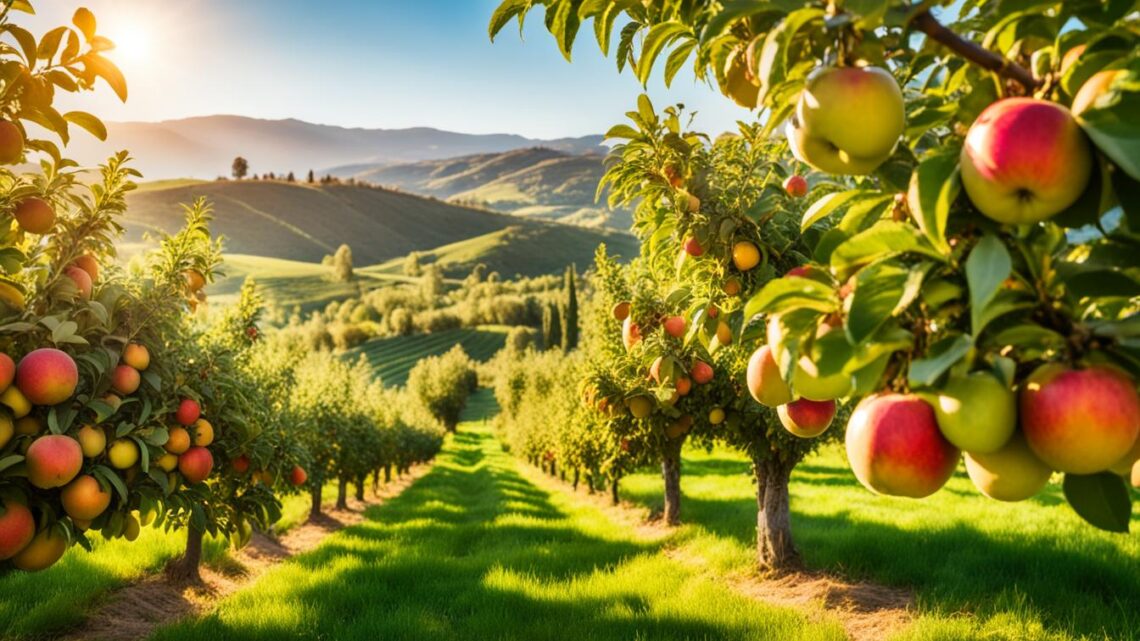
Do you dream of a garden full of sweet smells and buzzing bees? Check out a wide range of popular fruit trees for your garden. You can find everything from classic apples and pears to special fig, cherry, and plum trees. But which ones will work best in your garden? Let’s explore the best fruit trees for your space and climate.
Growing Your Dream Orchard
Starting your dream orchard needs careful planning. Think about the climate and space you have in your garden first. Choose fruit trees that fit the space they’ll need when they grow big.
Also, pick fruit trees that like the growing conditions in your area. Different trees do best in certain temperatures and amounts of rain. Check what your soil type is like too. Fruit trees like certain soils for growing well.
Space and Climate Considerations
Use the USDA Plant Hardiness Map to find the right fruit trees for your area. Big trees can get up to 20 feet wide. Semi-dwarf trees are 12 to 15 feet wide, and dwarf trees about 10 feet. Plan your orchard so each tree has enough room to grow.
Soil Requirements
Fruit trees do best in soil that drains well and has lots of nutrients. The soil should be a bit acidic, between 6.0 and 6.5 pH. If your soil isn’t right, you might need to add something to help it.
Pollination Needs
Know if the fruit trees you want need pollination help. Some trees can pollinate themselves, but others need a friend tree nearby. Make sure your orchard layout has space for any pollinator trees you need.
Think about space, climate, soil, and pollination when planning your orchard. This way, you’ll have a garden that’s full of fruit for years.
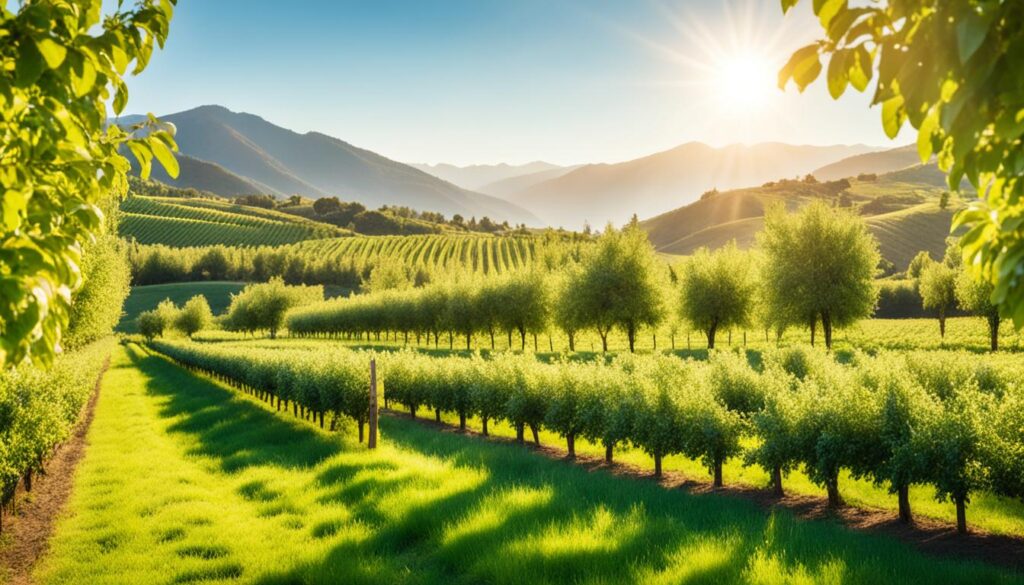
Pear Tree Varieties
Easy to Grow and Disease-Resistant
Pear trees are great for beginners. They grow well in many climates and fight off diseases and pests easily. These trees are perfect for those who like organic gardening. Some pear trees start producing fruit in just 3 years, while others take up to 7 years.
The Bartlett, or Williams pear, is a favorite. It needs about 800 chill hours a year. Baldwin pears need around 150 chill hours, and Kieffer pears need 350-400 chill hours.
| Pear Variety | Chill Hour Requirements |
|---|---|
| Bartlett | 800 chill hours |
| Baldwin | 150 chill hours |
| Kieffer | 350-400 chill hours |
| Hood | 100-200 chill hours |
| Pineapple | 150 chill hours |
| Summercrisp | 700-800 chill hours |
| Moonglow | 500 chill hours |
| Shinko Asian | 450-500 chill hours |
| Shinseiki Asian | 250-450 chill hours |
| Flordahome | 150-250 chill hours |
| Seckel | 500-800 chill hours |
Pear trees are easy to care for and fit many climates. They’re great for home gardens. Pick the right type based on your area’s chill hours for tasty pears right from your yard.

Apple Tree Varieties
Classic Favorites for Beginners
The classic apple tree is a favorite for home gardens. It’s easy to grow, produces a lot, and is tough in many places. For beginners, apple tree varieties like Honeycrisp, Gala, and Red Delicious are great picks. They come in sweet, crisp, tangy, and juicy flavors. This makes them perfect for eating fresh, baking, and canning.
Dwarf vs. Standard Apple Trees
For gardeners with little space, «dwarf» apple trees are a good choice. They grow 10-15 feet tall and can start producing apples in 2-3 years. This is faster than standard trees, which can be 20 feet tall and take 8 years to bear fruit.
Most apple trees need another tree nearby to pollinate well. With the right trees and care, you can have a successful apple tree at home.
| Rootstock Type | Tree Height | Fruit Production | Time to Bearing |
|---|---|---|---|
| Seedling or Standard | 20+ feet | Up to 10 bushels | 8+ years |
| Semi-Dwarf (M.26, MM.111) | 12-15 feet | 4-7 bushels | 4-6 years |
| Dwarf (M.9, M.27) | 8-10 feet | 1.5-3 bushels | 2-3 years |
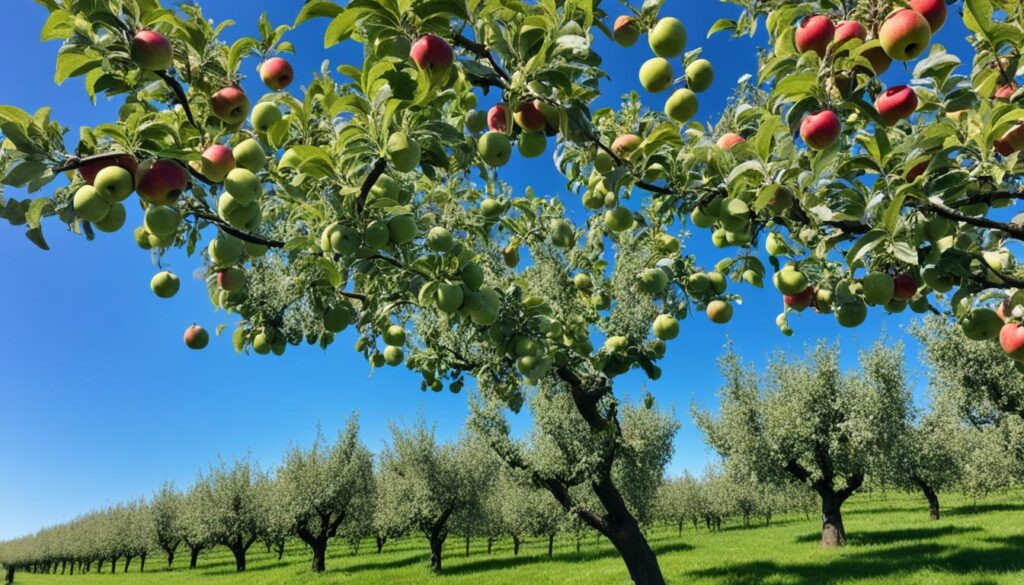
Fig Tree Varieties
Figs are easy and fun to grow, perfect for many climates and small spaces. They fight off diseases well, pollinate themselves, and grow fast. You won’t wait long for your first figs. Whether you pick a green or purple fig, they’re a tasty, easy choice for your garden.
There are about 800 fig types in the Ficus genus. Each garden can find a fig tree that fits. The top fig trees for eating are:
- Black Mission fig trees, loved in California, give a light early and big main crop.
- Brown Turkey fig trees grow 10 to 20 feet tall and wide, with a big main crop in early fall.
- Celeste fig trees are tough and small, 5 to 10 feet tall, with a light early and big main crop.
- Panache Tiger Stripe fig trees, about 12-15 feet tall, need a warm place and have a late-ripening main crop.
- Desert King fig trees grow fast, 15 to 25 feet tall and wide, with super sweet green fruit.
Choosing any fig tree means getting yummy, full-of-flavor figs. They’re easy to care for and fit well in any garden or orchard.
| Variety | Growth Habit | Fruit Characteristics | USDA Zones |
|---|---|---|---|
| Black Mission | Medium, 20 ft tall and wide | Light breba crop, heavy main crop, dark purple skin, red flesh | 8-10 |
| Brown Turkey | Medium, 10-20 ft tall and wide | Large main crop in early fall, less sweet breba crop, brown skin, pink flesh | 7-10 |
| Celeste | Dwarf, 5-10 ft tall and wide | Light breba crop, main crop, brown-violet skin, pink flesh | 6-10 |
| Panache Tiger Stripe | Semi-dwarf, 12-15 ft tall | Late-ripening main crop, unique yellow and green striped skin, red flesh | 8-10 |
| Desert King | Fast-growing, 15-25 ft tall and wide | Green skin, very sweet flesh | 8-10 |
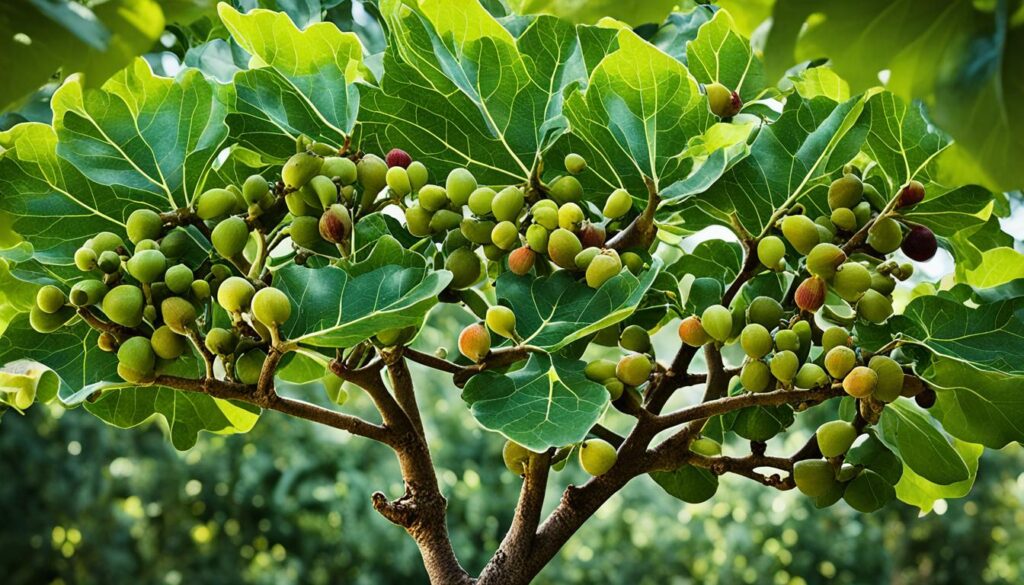
Cherry Tree Varieties
Bing Cherries for Beginners
If you’re new to growing fruits, Bing cherry trees are a great pick. They grow sweet, plump cherries perfect for baking, making jams, or just snacking. Remember, it takes about 4 years for these trees to start producing cherries. Also, birds love cherries, so protect your trees after they bloom to get a good harvest.
Bing cherries are easy to grow and give lots of fruit. With some care, you can enjoy their rich color and sweet taste right from your garden.
| Cherry Tree Variety | Regular Price | Sale Price |
|---|---|---|
| Lapins Cherry Tree | $44.95 | – |
| Dwarf Bing Cherry Tree | $49.95 | $44.95 |
| Double-Cherry Twist Tree | $59.95 | $49.95 |
| Rainier Cherry Tree | $44.95 | – |
| 4-in-1 Cherry Jubilee Tree | $69.99 | $64.95 |
There are many cherry tree types to choose from, like Bing, 4-in-1, and double-twist. Each has different sizes, flavors, and prices. You’ll easily find the right one to make your garden full of cherries.
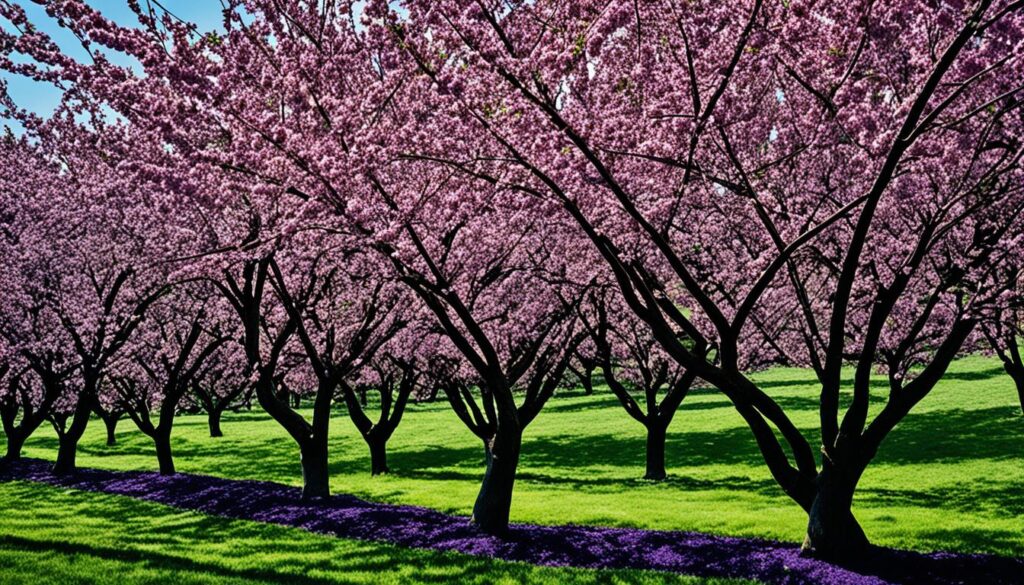
Plum Tree Varieties
There are many plum tree varieties to choose from when planting. You can pick from Japanese plums for their rich flavors, American plums for their toughness, or European plums for their sweet taste. Each type has its own special traits, like how it grows and what kind of weather it likes. It’s important to think about your garden’s conditions and what you like when picking a plum tree.
Soil Drainage Considerations
When planting plum trees, make sure the soil drains well. Plum trees don’t like wet soil, which can cause root rot. Before planting, check how well your soil drains. It should drain well and have a pH of 6.0 to 6.5. If your soil is heavy or clay, add organic matter or raise the bed to help with drainage. This will keep your plum tree healthy for a long time.
| Plum Tree Variety | Climate Suitability | Tree Size | Bearing Age |
|---|---|---|---|
| European Plum | Zones 5-8 | 15-25 ft | 3-6 years |
| Japanese Plum | Zones 5-9 | 15-25 ft | 3-6 years |
| American Plum | Zones 3-4 | 15-25 ft | 3-6 years |
| Dwarf Plum | Zones 5-9 | 8 ft | 1-3 years |
With the right care and conditions, you can grow delicious plums in your garden. You can choose from tall trees or smaller dwarf varieties. Plum trees offer a wide range of options for every gardener.
fruit tree varieties
You can grow apricots, lemons, and crabapples in your garden too. Apricot varieties are easy to grow and give lots of fruit. But, they bloom early and can be hurt by late spring frosts.
Lemon tree varieties love warm places and can grow in pots or indoors. They add a citrusy feel to your garden. Crabapple varieties may not have the best fruit, but their flowers are beautiful. Some can even handle very cold weather.
| Fruit Tree Variety | Original Price | Current Price |
|---|---|---|
| Apricot | $39.99 | $34.99 |
| Lemon | $49.99 | $44.99 |
| Crabapple | $59.99 | $54.99 |
There are many prices and types to choose from. You can pick the perfect apricot, lemon, or crabapple tree for your garden and budget. These trees add color, fragrance, or whimsy to your space.
Berries and Other Fruit Plants
Fruit trees aren’t the only tasty choices for your garden. Many berry plants and unique fruits can grow well. Marionberries have a strong, complex taste like a mix of blackberry and raspberry.
Black raspberries are also a hit for their strong taste. They are the most intense and complex of all raspberry types.
Marionberries and Black Raspberries
Marionberries and black raspberries come from the Rubus genus. They are known for their rich flavors. Marionberries are a type of blackberry with a deep purple color and a bold, sweet-tart taste.
Black raspberries have a strong raspberry smell. They also have a complex flavor with many layers.
Goumi, Alpine Strawberries, and More
There’s more to explore beyond the usual berries. The Carmine Goumi has big, sweet-tart fruits. The Alpine strawberry is also fragrant and adds variety to your garden.
Whether you like the deep taste of marionberries, the raspberry flavor of black raspberries, or the unique taste of goumi and Alpine strawberries, there’s a lot to try. These fruits offer a world of delicious options beyond the usual fruit trees.
Grapes and Muscadines
The world of grapes has many flavors and types to try. You might like classic European grape varieties or want something new. Adding grape vines to your garden can give you lots of grapes and a great experience.
Muscadine grapes are a great choice for something different. They grow in the American South and are tough against diseases. They also have a sweet-tart taste. These vines do well in warm, humid places, which helps them with climate change.
| Grape Variety | Climate Suitability | Disease Resistance | Flavor Profile |
|---|---|---|---|
| Vinifera Grapes | Temperate Climates | Susceptible to Disease | Complex, Nuanced Flavors |
| Muscadine Grapes | Hot, Humid Climates | Highly Disease-Resistant | Sweet-Tart, Aromatic |
Muscadine wines are often sweeter, but some makers are trying drier styles. These wines may not be as known in the wine world. But, they offer a special taste for those who like to try new things.
Choosing to grow grape varieties or muscadine grapes can make your garden better. It gives you lots of grapes and adds to your cooking fun.
Pawpaws and Unique Varieties
There’s a world of unique and tasty fruit trees to explore. Pawpaw trees, also called the «temperate banana,» have a tropical taste. They are often better than bananas. The Indian Free peach is another great choice. It mixes the best of yellow and white peaches for a unique flavor.
For those who love trying new things, these fruits can make your garden special.
Indian Free Peaches and More
Pawpaws are great, but there are more unique fruit varieties to try. The Indian Free peach is a mix of sweet yellow and white peaches. It’s just the start of the exciting fruits out there.
- Pawpaw trees need warm summers, mild winters, and steady rain to grow well.
- These trees grow to be 15 to 20 feet tall. They’re not grown for sale because the fruit is soft and doesn’t keep long.
- Grafted pawpaw trees are two years old. They are grafted to keep the fruit’s best traits.
- Popular pawpaw types include Sunflower, Taylor, Taytwo, Susquehanna, and Shenandoah.
Trying new fruits can be very rewarding. The pawpaw’s tropical taste and the Indian Free peach’s unique flavor can make your garden and cooking special.
Growing Citrus in Containers
Many fruit trees need a lot of space, but citrus trees can do well in small gardens or on patios. Lemon, lime, orange, and grapefruit trees can grow in pots and come inside during cold winters. With the right care, you can have fresh, tasty citrus fruits from your own place.
Choose a pot that’s at least 12 inches wide for small trees, and bigger for bigger trees. Citrus plants need six to eight hours of sunlight a day. Put the pot in a sunny spot. Use a good potting mix like Pennington Ultra Grow for consistent moisture and nutrients.
Feed your citrus trees with citrus plant food like Pennington Ultragreen Citrus & Avocado 10-5-5. This keeps them healthy. Prune them a bit to keep them small and make more fruit. Follow these tips for a lot of fresh citrus from your patio or balcony.



